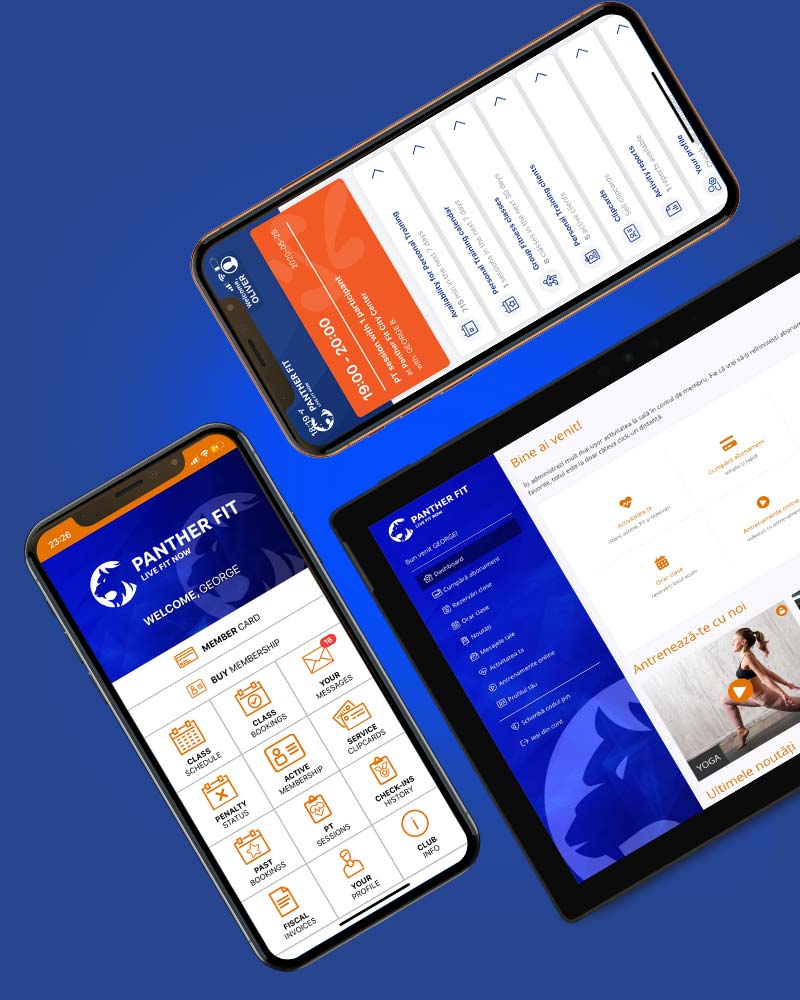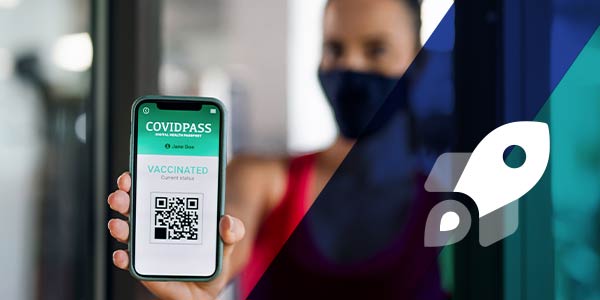How to check-in members at your gym
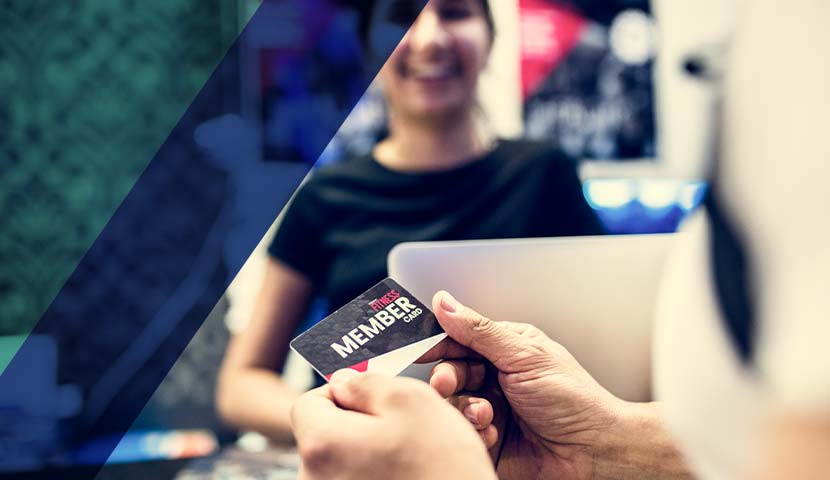
Member check-in or access validation is one of the simplest and most common actions at any fitness club. This process ensures that the member has access to the gym or certain services at the club. It is not a complex operation, but it has multiple variants that can take a few seconds or minutes on end.
Since this operation is performed so often, the gym manager must choose the simplest and fastest solution for both members and the staff that actually handles this process every day.
What is a check-in process, and why is it important
Checking a member in the gym has two parts: validating the member's access and registering their visit.
When someone visits the gym, your team at the front desk confirms their identity in your database, which has information on their membership. If the member's membership provides access to that gym, at that time of day, your staff will check the member in, and they will be let into the gym.
At the same time, the date and time of the visit are recorded in the database, in the member's profile, for security purposes. Also, to generate useful reports on the number of members that use their memberships and at what frequency.
These reports can easily highlight different trends and give you a bird's eye view of your business' success. Moreover, depending on the number of check-ins, you can quickly identify members that don't use their membership and are in danger of dropping out.
The process of checking members in is essential because, first of all, it makes sure the person trying to get in actually has an active membership. Since the primary revenue of any gym is selling memberships, it's vital to make sure there are no ways for individuals to enter your gym without paying.
To help with this situation, a member check-in system should also validate the identity of the person visiting. You can do this by asking for that person's ID, but that might be problematic. The person can refuse to show it or simply doesn't have it on them. Also, this process can take minutes for each member, thus prolonging the check-in operation.
A simpler way is to take a portrait photo of each member, preferably when they purchase their first membership or when they visit the gym for the first time. The image should be saved in the member profile, and your staff can quickly check if the photo matches the person in front of them.
A third way to check a member's identity is by using biometric data, such as fingerprints, an eye scan, or facial recognition. However, these systems are much more expensive, and members might not feel conformable with you having such sensitive data about them.
How to check a member into the club
Usually, a check-in process entails manually searching for a member in the database, using their name, email address, or phone number. Unfortunately, most member management software only provides this option.
This is not a complicated process, but it can take a few minutes while the member dictates their name, email, or phone number, and the staff at the front desk fills in the search form. In some cases, there might be more than one profile with the same information, which will prologue the process.
More sophisticated management software provides a much simpler way to identify the member in the database, using a unique code. This code can fie encoded in various forms on plastic member cards, QR codes generated by an app, or RFID systems. Then, when you scan the card, the app, or the RFID device, no matter the method, the management system will quickly identify the member profile with that unique code in the database. It will also display the member profile, photo, and membership, if there is any.
If everything is in order, the system will check the member in automatically and save the date and time of the visit, so the information can be used later.
An old-school method for verifying members are using an Excel document where you have a list of active members, their membership, and expiration date. Though this system might be satisfactory for a gym with a handful of members, it will never be enough if it wants to expand and recruit new members in the future.
If you only have a few dozen members, you can quickly check a list of names and confirm their membership. That's why CTRL+F was invented. However, with this system, you can easily make mistakes. For example, what happens if two members have the exact same name? What if an employee put the wrong membership or expiring date?
If you manage your members using pen and paper, you are also open to these mistakes, and you don't even have the CTRL+F feature.
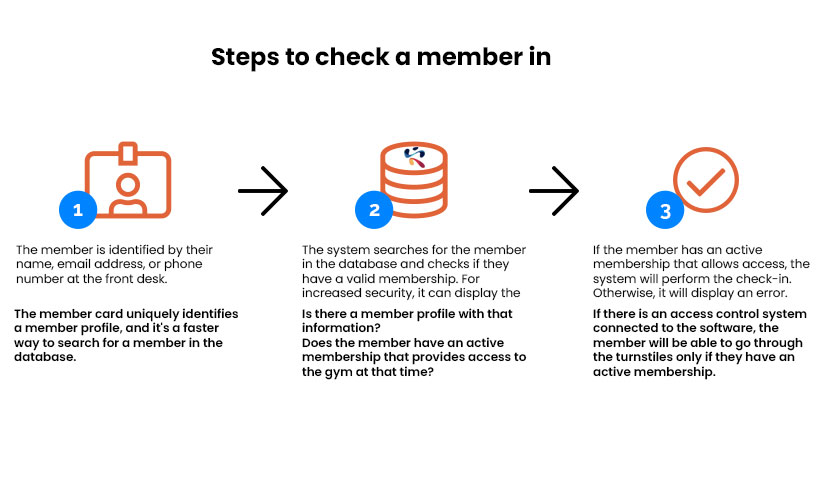
Check-in with a member card
This is the simplest and most popular way to check members in. It usually involves a plastic card, similar to a bank card, that bears the gym's name and logo, and sometimes the member's name. These cards can have a magnetic stripe or a barcode, and both have a unique identification code for that member.
You need a dedicated reader for cards with a magnetic stripe, also known as a swiper. Each card has a unique code encoded on the magnetic strip allocated to a member profile in the database. When the member visits the gym, the swiper reads the card. The system reads the code on the card and uses it to identify the member profile in the database. Once it's identified, the system displays the information in the profile, including the member's photo and what membership they have.
The cards with barcodes or QR codes work the same way. The only difference is that they don't have a magnetic stripe, but a barcode or a QR code printed on them, just like a product's label. That code is allocated in the system to a member profile, and the staff at the reception desk needs a barcode/QR code reader to scan the card.
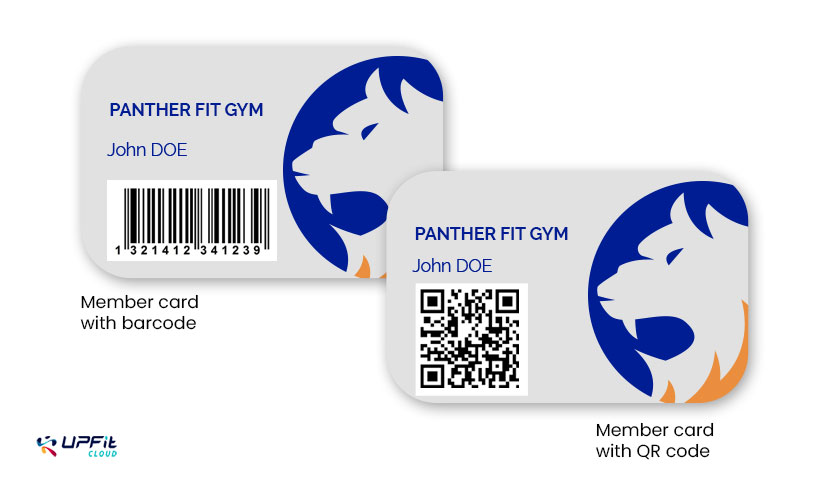
The great advantage of such a system is that it's relatively easy to implement and doesn't require sophisticated equipment. Also, the price of a card is negligible. Still, it can become a serious investment if your members constantly lose their cards. At the same time, member cards are also helpful when the locker key must be handed to the reception desk. Those cards can be left instead of the key, and if someone leaves with a key, you'll know who it was.
The main disadvantage is the cards can easily be damaged, and many times members will lose them or forget them at home. Because of these, many fitness clubs require members to pay for these cards when they buy their first membership or in case they need to have them replaced.
Check-in with RFID
RFID stands for Radio-Frequency Identification. The members' information is encoded on a chip embedded in a card, like those described above, or a plastic bracelet. The card or the bracelet is scanned with an RFID reader. The system will receive the code encoded on the chip and identify the member profile in the database. The card or the bracelet must be near the required reader to scan an RFID chip.
The advantage of this check-in method is that members can check-in themselves. Also, the RFID reader can be embedded into an access control system, which might eliminate the necessity of a reception desk. Moreover, the same RFID card or bracelet can be used in other parts of the club.
For instance, the same card or bracelet used for check-in can also be used on the turnstiles at the entrance. Members can lock or unlock a locker cabinet or access restricted areas based on their membership. For example, the member can access the pool only if they have a valid membership that includes access to this service.
The main disadvantage of this system is the implementing cost and the fact that most operations are performed by members who don't always understand what to do. Moreover, if the RFID check-in is integrated with an access control system, your team at the front desk might still have to check the members' identity since a card or a bracelet can easily be lent. Like cards with magnetic stripes or barcodes, RFID devices can also be lost, left at home, or damaged.
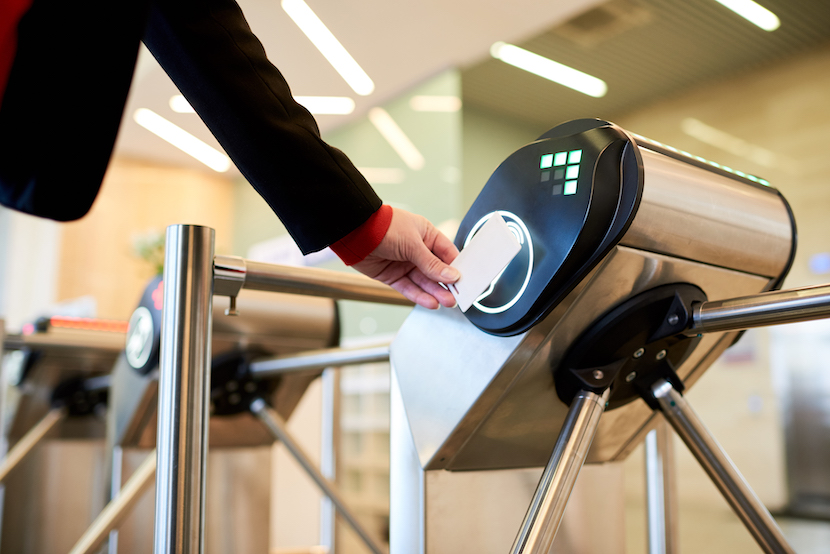
Check-in using a digital member card
A digital member card is usually in a mobile app integrated with the gym's management system. That member downloads the app from the store on their phone and logs in with unique identification data generated by the management system. Usually, that entails the member's email address and a password or a pin code.
Based on these login details, the app access the member account of that user. There is a QR code in one of the sections that the member can scan at the gym's entrance to check in.
The system works just like a barcode card, and you need a similar reader that can read QR codes. When a member visits the gym, they scan the QR code on their phone.
The management system identifies the member profile and validates their access, both in the gym and other areas of the club.
You can make specific setups so that the system can identify members that use the same account on more than one device. That usually means they are sharing their login information with other people and, subsequentially, their membership as well. Then, when the member checks in through the access control system, the management planform will get the unique ID of the member's device, alongside the unique member code. Suppose a member uses more than one device when checking in. In that case, the system will display an alert, and your team can verify the situation.
You can also configure the app so the QR code is regenerated every few seconds, so members can't use print screens.
This system is useful, particularly for gyms with an access control system that doesn't rely on the reception desk to validate the member's access.
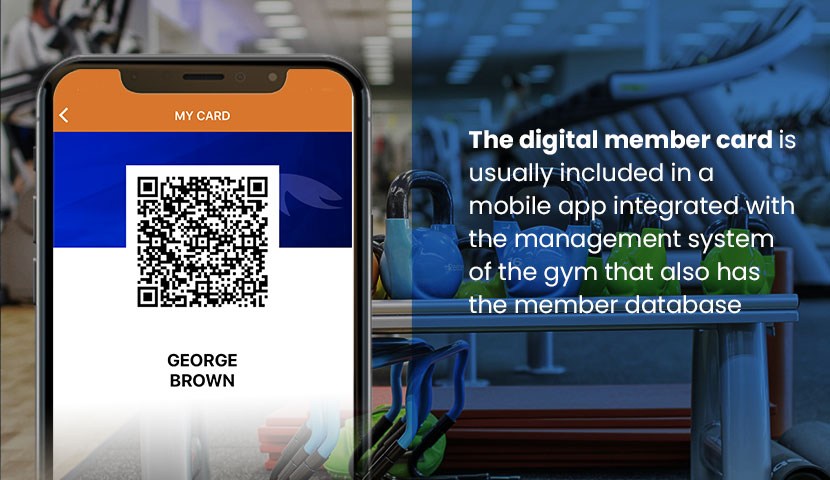
The main benefit of a digital member card is that it doesn't require cost for the club. A member app has plenty of benefits and allows members to perform many operations independently, from class bookings to membership renewals. A mobile app does require an investment, but it is not solely for the member's check-in.
What is more, with a digital card, you don't have to worry about replacing lost cards, and the chances of a member forgetting their phone at home are very slim.
The main disadvantage of a digital card is that probably not all your members are digitally savvy. Therefore, they might not be too keen on downloading the app and figuring out how to log in. Also, as stated above, a mobile app requires some costs to create, maintain, and provide updates.
Check-in based on biometric data
It's crucial to confirm the member's identity when using access control systems that don't require a front desk. You can do this with a check-in system based on biometric data.
Most often used biometric data is a fingerprint or a palmprint. You can also use the shape of the member's face or iris. When someone buys a membership for the first time, you must scan their fingerprint, iris, or face. These biometric data are saved into their member profile. When they come to the gym, during check-in, they must scan their finger, palm, face, or iris to confirm it's them.
You should bear in mind that such a system doesn't work on its own because with biometric data, you cannot confirm a person's membership status. So when they check-in, members must also scan a member card, usually RFID.
Therefore, when the member checks in through the access control system, they must scan the RFID card to identify the member profile in the database and check the membership status. Then they must scan their fingerprint so the system can confirm that the individual scanning the card is also the person who bought the membership.
With such a system, your gym can work 24/7, without needing staff at the front desk.
The advantage of this system is that it identifies the member precisely. They can't go through the access control system if it's not them. Therefore, the system works on its own and can be implemented in various areas of the gym.
However, the disadvantage of this system is mainly financial because it can cost quite a lot, not just the actual devices but also the implementation and maintenance. Moreover, members might refuse to have their biometric data saved into your database, or using this system might confuse some members. That will cause some problems, particularly if you have a non-stop gym and don't always have staff present there.
A quick catch-up...
Checking members in at the reception desk is the most common process at a fitness club. That is why it's vital to pick a system that matches your gym's access flow and your members. There are various validation methods, from the most rudimentary, like checking a list of members with pen and paper, or in an Excel document, to complex systems that involve biometric data.
Depending on your fitness club and your expansion plans, you must choose a check-in system carefully. Then, implement it from the get-go, so your members can get used to it.
The most common way to check a member into the gym is based on a member card with a barcode or a magnetic strip allocated in the management system. When the card is scanned, the system identifies the member's profile. So your staff can quickly check if they have a valid membership.
Another method is the RFID cards or bracelets, which can be scanned directly by members and used for various purposes, including locking, unlocking locker cabinets, or accessing restricted areas like the pool or class studios.
A digital member card like a QR code in a mobile app is an easier way to check members in, eliminating the "I forgot my member card at home" issue. Systems based on biometric data are more accurate at confirming the members' identity and can be used for clubs without staff but are more costly and might put off members.
As you can see, each system has its advantages and disadvantages, depending on what kind of gym you are running. No matter what method you go for, it's essential to implement it from the beginning, teach members how to use it, and not allow them in the gym without checking in first.
Are you struggling to increase the number of new members joining your fitness center?
There is an easier way to get more members! Communicate efficiently with them through automated emails, provide them the option to purchase memberships online, delight them with a professional mobile app and member account, and surprise them with fast services at the reception desk.
With UPfit.cloud, everything is done quickly, and you can start seeing results in a matter of days. Find out the advantages of our platform in a 20-minute demo session.
REQUEST A DEMO
We also recommend...
Why it's important to have member contracts and how they help you
The member or service contract is helpful for gyms, mainly to avoid legal problems or misunderstandings with members.
Read More10 tasks members should perform themselves, without depending on your gym's front desk
For gyms, digitization means more than implementing management software. An important aspect of digitizing a gym is allowing members to control their own activities. This means that members can manage their own activity and account through online tools.
Read MoreHow to scan COVID certificates at your gym easier
Gyms now have a new challenge in managing their members - scanning COVID certificates. This is how you can implement this process at your gym's reception desk and what your digital options are.
Free guides for your gym
We have created a series of free guides that will help expand your gym: advice on increasing sales, lead management, optimising your online marketing strategy, creating a corporate program, and so much more. There are dozens of e-books and guides with useful information and ideas for ambitious gyms, that are willing to use all the tools available to grow their business and recruit more members.
Software that perfectly adapts to your gym's activity
Each gym is unique. That is why UPfit.cloud has a wide range of services, tools, and features that perfectly match your business.
Regardless of how you manage your gym or fitness club activity, UPfit.cloud can be customized so it's easy to use for your team and simple for your members.

Aerobic studio
Discover the benefits
Fitness center
Discover the benefits
Pilates studio
Discover the benefits
Yoga studio
Discover the benefits







